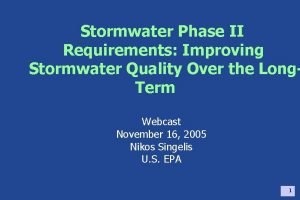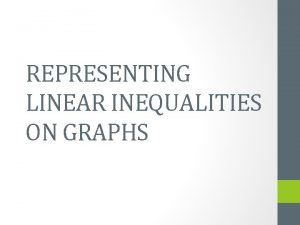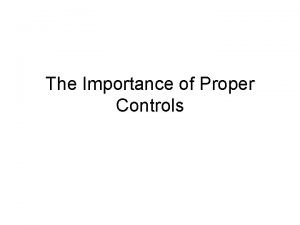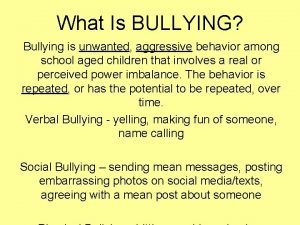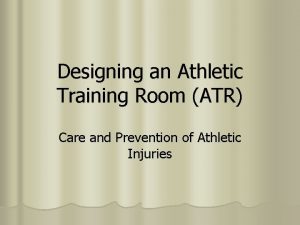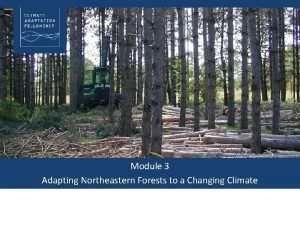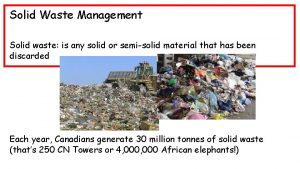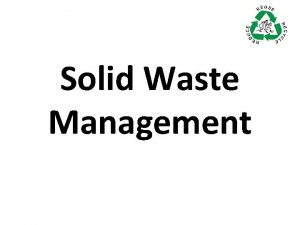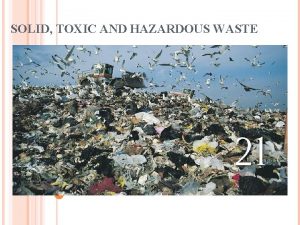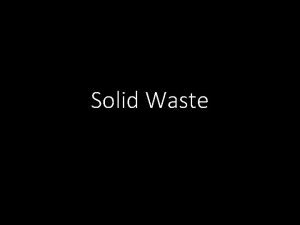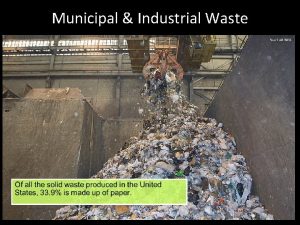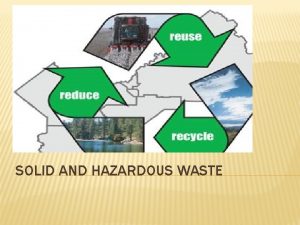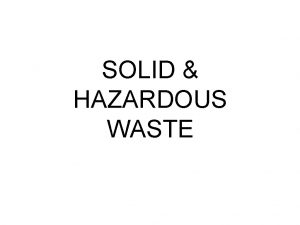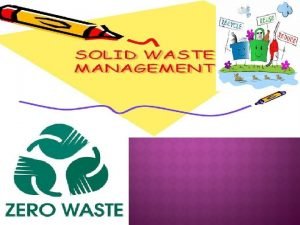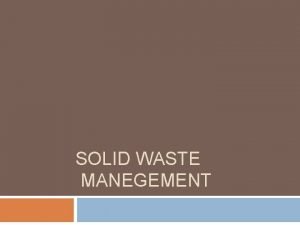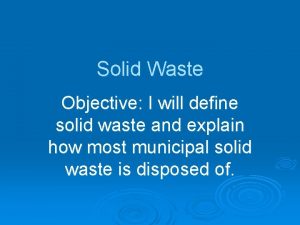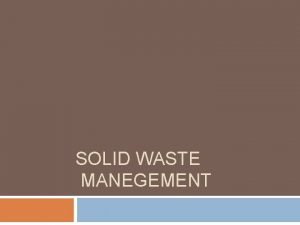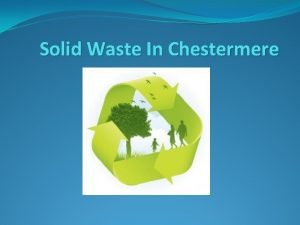WASTE TYPES OF WASTE Solid Waste any unwanted



















- Slides: 19

WASTE TYPES OF WASTE: Solid Waste: any unwanted or discarded material that is not a liquid or a gas. 98. 5% of the solid waste in the US comes from mining, oil and natural gas products, agriculture, and industrial activities used to produce goods and services for consumers. Mining Waste: is exempt from hazard waste classification and can be left piled near mining sites to pollute air, soil and water. Industrial Solid Waste: includes scrap metal, plastics, paper, fly ash, and sludge from industrial waste treatment plants. Most is buried or incinerated onsite. Municipal Solid Waste: (MSW) = garbage from homes and businesses in or near the areas. Approximately 1500 pounds person in the USA.

WHAT IS HAZARDOUS WASTE? Hazardous Waste: any discarded solid or liquid material that: a. contains 1 or more of 39 toxic, carcinogenic, mutagenic, or teratogenic compounds at levels that exceed established limits (solvents, pesticides, paint strippers). b. Flammable (gasoline, paints, solvents) c. Reactive or unstable enough to explode or release toxic fumes (acids, bases, ammonia, chlorine bleach) d. Capable of corroding metal containers such as tanks, drums, barrels (industrial cleaning agents, oven and drain cleaners).

WHAT ISN’T CONSIDERED HAZARDOUS WASTE? Ø- radioactive waste Ø- household hazardous waste Ø- mining waste Ø- oil/gas drilling waste Ø- liquid waste (organic hydrocarbons) Ø- small business that generate less than 220 lbs. Of hazardous waste per month. 94% of the country’s hazardous waste is NOT regulated by hazardous waste laws!!!

HAZARDOUS WASTE

How Can We Manage Hazardous Waste? Hazardous Waste Detoxification – convert hazardous waste into less hazardous material Bioremediation – bacteria are used to destroy toxic or hazardous waste or convert them to less harmful forms (mimics nature) Phytoremediation – natural or genetically engineered plants to remove contaminants (blue-green algae are commonly used) Incineration – all incinerators burning hazardous waste or solid waste release toxic air pollutants such as lead, mercury, dioxin (can’t be removed by scrubbers). This causes severe health threats and is costly to conduct.

HOW CAN WE MANAGE HAZARDOUS WASTE? Land Disposal – deep-well injection; liquid hazardous waste is pumped into dry, porous formations below aquifers. Surface Impoundments – ponds, pits, lagoons that threaten groundwater and compounds evaporate into air. Landfills – hazardous materials buried in drums. PROBLEM: When landfills contaminate groundwater the landfill operator will declare bankruptcy, the EPA will list the site as a SUPERFUND site and tax payers will pay for the clean up! Export – export hazardous waste to save money and escape US regulations for waste disposal. Send it to other cities and counties. Developing countries make a lot of $ for dumping illegally or legally. Canada and Mexico receive 98% of US hazardous material!

ASSOCIATED HEALTH PROBLEMS Lead Exposure: 12, 000 -16, 00 American children per year suffer from acute lead poisoning. Approximately 200 die per year and 30% suffer from palsey, partial paralysis, blindness, and mental retardation. Maximum Legal Limit: 10 micrograms per deciliter. Since 1972, numbers have dropped tremendously due to phasing out of leaded gasoline in USA.

WHAT CAN BE DONE ABOUT LEAD? 1. Test all children by age 1 for lead 2. ban incineration of solid hazardous waste 3. phase out leaded gasoline worldwide 4. test older homes for lead paint 5. ban lead in plumbing pipes, fixtures and food cans 6. remove lead from municipal drinking water systems 7. wash fresh fruit and vegetables thoroughly 8. Re-evaluate proposed ecocars that use leadbatteries.

DEMOGRAPHICS OF LEAD

DIOXINS Chlorinated hydrocarbons usually formed as a product from incineration at high temperatures. It lingers in soil and human fat tissue for decades (carcinogenic). It promotes cancer by activating DNA already damaged by other carcinogens. Produces all different types of cancer NOT just 1 type! Vietnam/Desert Storm – US released dioxin = nerve gas. Dioxins can be eliminated easily by regulating incineration and boost the economy by implementing greener methods of waste disposal.

HUMAN IMPACTS Over the last 30 years, since the end of the Vietnam War, serious birth defects have been common in Vietnam. Scientists believe the dioxin in Agent Orange is causing the birth defects.

CHLORINE n Chlorine is a highly reactive gas used to purify water (chlorination), bleach paper and produce household bleaching agents. It accumulates in the body fat and can be harmful to human health. n n Chlorine is used mostly in the production of plastics (PVC piping), solvents and bleaching.

POLY VINYL CHLORIDE SIDING n n Presently, PVC is allowed to be incinerated!! BAN incineration of PVC! In the 1990’s Germany achieved chlorine-free paper bleaching and presently the rest of Europe is following. Presently the USA uses chlorine in tertiary treatment of STP’s (sewage treatment plants) and in drinking water chlorination processes. Should substitute with soaps, citrus-based products, and solutions of baking soda. Why don’t we? THE CHEMICAL INDUSTRY STRONGLY OPPOSES! (decreases profits)

HAZARDOUS WASTE REGULATIONS - USA n n n 1976 – Resource Conservation and Recovery Act (RCRA) – requires the EPA to identify hazardous wastes and set standards for their management. It also provides financial aid for states to establish waste management programs. Any firm that stores, treats or disposes of 100 kg (220 lbs. ) of hazardous material/month must have a permit stating how the wastes are managed, they must keep records, and supply them to the EPA when requested. PROBLEM: Not enough EPA personnel to keep up and enforce the regulations or fine illegal dumpers.

SUPERFUND n 1980 SUPERFUND ACT – “Comprehensive Environmental Response, Compensation, and Liability Act” – established a 16. 3 billion dollar superfund by federal and state government taxes on the chemical and petrochemical industry. n n Purpose: to identify and clean up abandoned hazardous waste dump sites such as Love Canal and leaking storage tanks that threaten the environment and human health.

LOVE CANAL

SUPERFUND TODAY EPA identifies the liable polluters, orders them to clean up and pay for the cleanup and sues them if they do not comply. The EPA established the National Priority List (1, 100 sites) PROBLEM – SUPERFUND went broke. Most areas for future listing are government related sites run by the Department of Energy or the Department of the Interior. 1993 NYPIRG campaigned strongly and convinced the New York State Legislature and Governor Pataki to enact a law to refinance the State Superfund and create a new brownfields cleanup program. the new law maintains the Superfund's tough clean-up criteria, expands the Superfund to include "hazardous substance sites, " maintains the historic 50/50 split between industry fees and public funds, provides technical assistance grants for community groups, and refinances the Superfund with an annual projected budget of $120 million. This was a huge victory for communities across the state, where one in four New Yorkers lives within a mile of a Superfund site!

SUPERFUND SITES

HOW DO WE ACHIEVE A LOW HAZARDOUS WASTE SOCIETY? 1. Grass roots organizations 2. Don’t cut deals with polluters and regulators to compromise our children’s future 3. Hold polluters and regulators accountable 4. Oppose ALL hazardous waste landfills and deep disposal wells and incinerators (pollutes, air water and soils)…THERE IS NO SAFE DISPOSAL OF HAZARDOUS WASTE! 5. Pressure elected officials to pass legislation to ban hazardous exports from one country to another. PREVENTION IS BEST!
 Types of transfer stations in solid waste management
Types of transfer stations in solid waste management Open letter example format
Open letter example format It is an unwanted aggressive behavior
It is an unwanted aggressive behavior Represent linear inequalities
Represent linear inequalities Corrective controls reveal or discover unwanted events.
Corrective controls reveal or discover unwanted events. Unwanted aggressive behavior
Unwanted aggressive behavior Quotes about being unwanted
Quotes about being unwanted Unwanted roomatr
Unwanted roomatr It is an unwanted, aggressive behavior. *
It is an unwanted, aggressive behavior. * Unwanted
Unwanted There is there are
There is there are Any to any connectivity
Any to any connectivity Pertanyaan terbuka
Pertanyaan terbuka Honors its atomic
Honors its atomic Solution solid
Solution solid Covalent network solid vs molecular solid
Covalent network solid vs molecular solid Crystalline solid and amorphous solid
Crystalline solid and amorphous solid Crystal solid and amorphous solid
Crystal solid and amorphous solid Crystalline solid and amorphous solid
Crystalline solid and amorphous solid Crystalline substances
Crystalline substances
